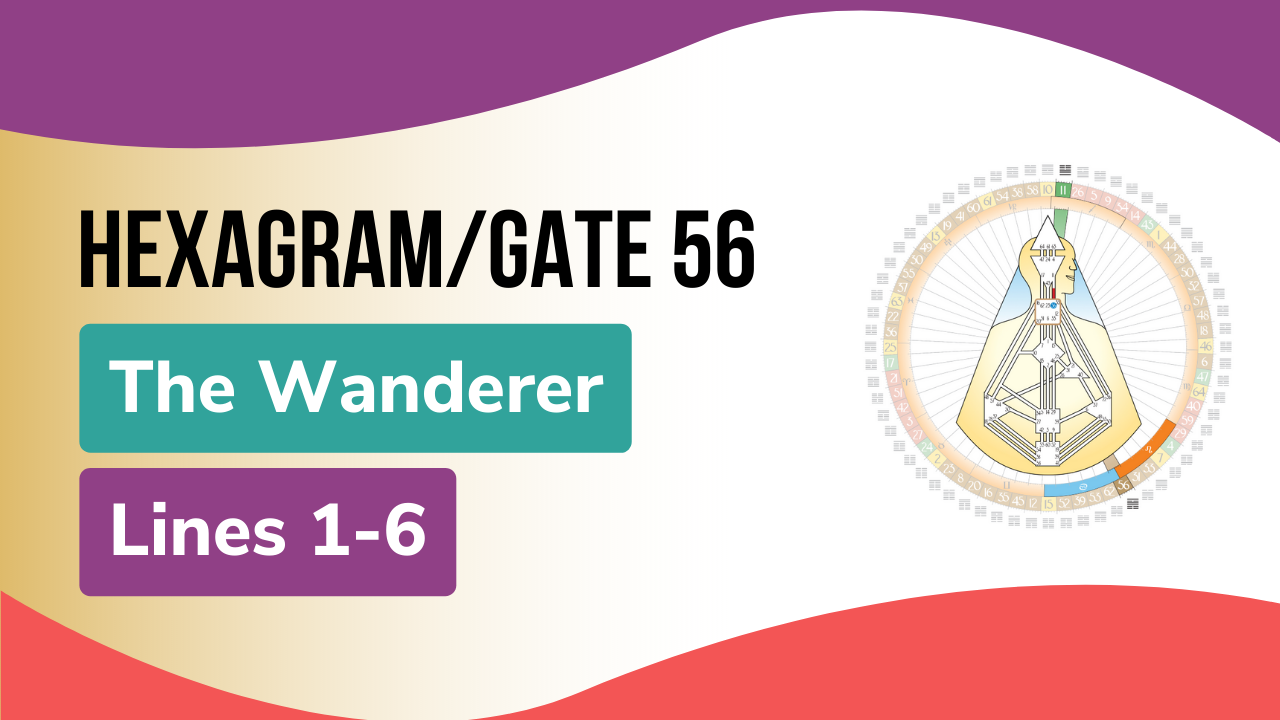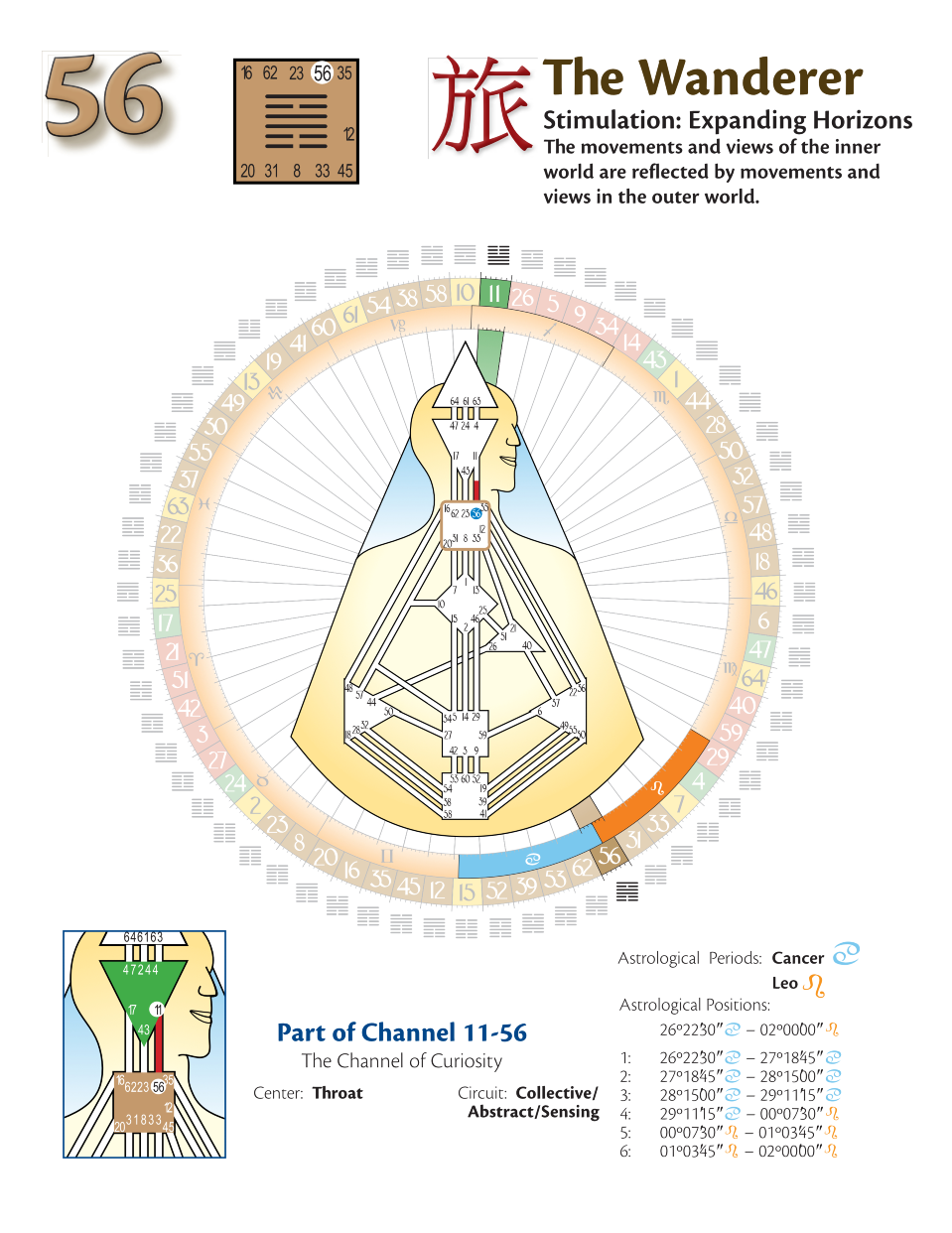Last time, we explored Hexagram 62, which was about expressing the details that outline our life journey. Now, the sun is moving into Human Design Gate 56, which we call “The Wanderer.” Where the 62 was about expressing details in a logical, even scientific way, with the 56th gateway, we get the other side of the coin: the abstract, or the sensing point of view, expressing beliefs, ideas, stories and things that are potentially stimulating.
The thing about beliefs is that they can sometimes lead to dogma, especially when it comes to religious beliefs. You’ve undoubtedly met somebody in your life who is a “true believer”, somebody that’s totally stuck in a dogma, stuck in their creed. And you’ve undoubtedly discovered that there’s just no talking to these people. There’s no room for discussion or friendly debate. There’s no room for questioning or exploration. But the great thing about life is that it’s always moving on. And that’s exactly what the Wanderer does.
The Wanderer is always moving into new experiences in life, new possibilities. If you have the 56 in your chart, you have a tendency to love traveling, to love moving around, to look for adventure. You’re a seeker, a searcher. No stone is left unturned because you’re never stuck in dogma. You’re always updating your belief systems.
You’re constantly taking in what you see going on in the environments around you. The movements and views of your inner world are reflected by the movements and views in the outer world. As you wander and move through different experiences and different settings, you’re picking things up, you’re putting a story together. Even when doing something as simple as going to the grocery store, you’re picking up every detail about the people and environments you encounter along the way.
In a way, the whole journey of life is about matching the inner world with the outer world. It’s about finding those connections and reflections between yourself and the people and places around you. It’s the experience of you being someone who is at home in your own world. So, as you wander, you find your uniqueness, but lose the sense of separateness.
Let’s see what we find as we go through Human Design Gate 56 line by line:
First Line: Being Intentional
The first line is called “Being Intentional: Avoiding being distracted and drifting through your life.” So many people drift through life, checking off milestones along the way: birth, marriage, kids, death. That’s it. But life is not supposed to just be a slow march to the grave. We have this extraordinary possibility here. We have the possibility to experience, to see and feel and be in and of this world around us. So, while we’re here, let’s be intentional. Let’s be engaged.
Being purposefully engaged in your life, or not, qualifies the value of all of your life experiences. If you’re going to have an experience, there’s no use doing it in a half-hearted way. Good or bad, right or wrong, don’t let the moment go past you. Go into it fully, because whatever happens, you’re here to have that experience. So, bring your whole self into it.
Your speech can be mostly escapist to avoid your personal responsibility for what is said. There can be a tendency to brush things off. But this is just avoidance. If it all gets a bit too much, too rushed, there can be this tendency to just let the current take you and just drift through life whether it’s the right path for you or not. And we have to be really careful about this. Don’t waste the lifetime.
Second Line: Welcoming
Second lines always come from this place of innocence, even unsophistication. They just drop into things in a natural way. And here, the line is called, “Welcoming: The gift of enhancing your world if you trust in yourself.” You have no idea what’s coming your way at any given time. But if you’re engaged and trusting in yourself, then you’ll know that whatever appears in front of you is right for you in that moment. The question is, what do you do with it? But that’s another story.
Attentive to the brightness in your world, you notice how life is perceived by others. The second line is at play in this world. There is an almost childlike way of wandering through life, chasing butterflies, experiencing the natural wonder of the world and the simple pleasures that are on display all around you. And through this openness and attentiveness you are able to connect to the world and others around you.
Relating innovatively in your life brings admiration and assistance in times of need, but your passion for storytelling can miss the needs and expectations of your audience. Your wonder at the experience of life is magnetic. It can be fascinating for others. But it can also lead you to prattle on about it a bit, and you can fail to notice when others aren’t quite following what you’re trying to put across.
Third Line: Being Thorough
The third line is called, “Being Thorough: Examining any and all fixed beliefs.” Third lines are always pushing the envelope. There’s a certain amount risk taking with the third line. And with that, they’re going to wander into difficulties sometimes. But you learn from those difficulties and challenges. And here, a big challenge for the third line is fixed beliefs.
You examine and update your beliefs, or you are careless how you associate them into your life. All of us know what it’s like to have a fixed belief until somebody or something comes along and bursts our bubble. It’s like you were on a railroad track with one single fixed destination and now there’s suddenly a huge array of possibilities in front of you.
You express your beliefs with conviction, and you have an ability to adjust them over time. This is part of the nature of the wanderer, the seeker, the searcher. Even if it’s slow to come about, there is the capacity for change, for expansion of your beliefs. But if you believe that your true harmony exists somewhere else, you’ll always be restless. When you’re constantly thinking that the grass is always greener on the other side of the fence, you’re never really present in your own experience. It becomes about escape rather than experience.
Fourth Line: Measuring
The fourth line is very influential. It wants everybody to be on the same page. It wants everyone to be involved in the same way. Here, the fourth line is called, “Measuring: Aligning your beliefs in the context of your life journey.” It’s about answering the question, for yourself: “Am I living my life according to my beliefs? Is my inner life aligned with what is being echoed from outside? Or have I totally bought into some kind of system based on someone else’s approach to life?”
You are alert to when and what you say and must be ready to talk your way out of trouble. Some people are just not going to agree with the fourth line presence. They’re just set. That’s just how it’s going to be for them. When this happens, it’s up to you to realize that that’s ok. They can have their way and you’re going to stay aligned with your way of doing things and won’t let them pull you off course.
Your sensitivity to the mood of the moment indicates what can be easily communicated, but your confusion over what needs expressing can make it hard to assert yourself effectively. Stay tuned in, stay intentional about what’s needed in the moment. If you’re not paying attention or not fully keyed into the present moment, you might find yourself confused and saying things that other people can’t really get, which can lead to a fallout.
Fifth Line: Storytelling
The fifth line is always in a position of being able to lead, to point things out, to hold the vision. And here, the fifth line is called “Storytelling: Drawing people to your tales and adventures.” You are crystal clear in how you relate ideas of worth or become vain and lose your way. Fifth lines tend to get caught up in the projections of others. People come to you to fix things, to show them the way. And this can cause you to get mixed up about exactly what it is you’re doing and why.
It’s very easy for you to get and keep people’s attention. When you start talking, people tend to listen. So, the most important thing is that you’re actually relating something that’s relevant and authentic and potentially practical in that moment. When you go off track a little bit or you start saying things that are outside the realm of people’s abilities to hear, it can make people uneasy and less likely to connect with what it is you’re trying to show them.
We all have different belief systems. Some people might be coming from a completely different place in their lives and in their beliefs. So, when you’re not attuned to that and just start talking at people from your particular point of view, it can be seen as confrontational, or even offensive, and you’ll more often than not end up being completely misunderstood.
Sixth Line: Re-examining
The sixth line is called “Re-examining: Assessing the boundaries of what is truthful.” Truth is an inside job. It’s an individual experience, and only as individuals do we recognize what truth is. So, the trick with the sixth line is finding a way to express things that comes across as truthful, while acknowledging that there are many different ways of expressing our belief systems.
Your beliefs shape your perception of reality, bringing a certain quality of experiences. What we believe is what gets to play out in front of us. But if we’re tuned in, we can see if these things really make sense in our lives or not. And that’s why belief (and in turn, truth), is such a changeable thing.
You experience and speak out about your inner beliefs as a constantly shifting reality. When you are able to see that your inner life is not matching the outer, you know that a shift is necessary. And it’s a wonderful thing to open up these new possibilities. Things were stuck in your way, blocking your path, and all of a sudden you get this great sense of freedom and potential.
You feel uncomfortable with consistent beliefs and do anything to confuse them. You can have a tendency to stir people up by saying things that potentially challenge their fixed beliefs. You perceive that people are living a life that’s completely inauthentic, and you might be inclined to shake them up a bit. And this might have its place from time to time, but it can also lead to all sorts of confrontations and complications. And the thing is, we’re here to find the delight in life. We’re here to be intentional about our life. Because when we do that, life is an amazing experience.
That’s Human Design Gate 56. We’ll check in again soon. In the meantime, if you’d like to learn more about how your Design informs and shapes your life, get your
Free Human Design Report today.




